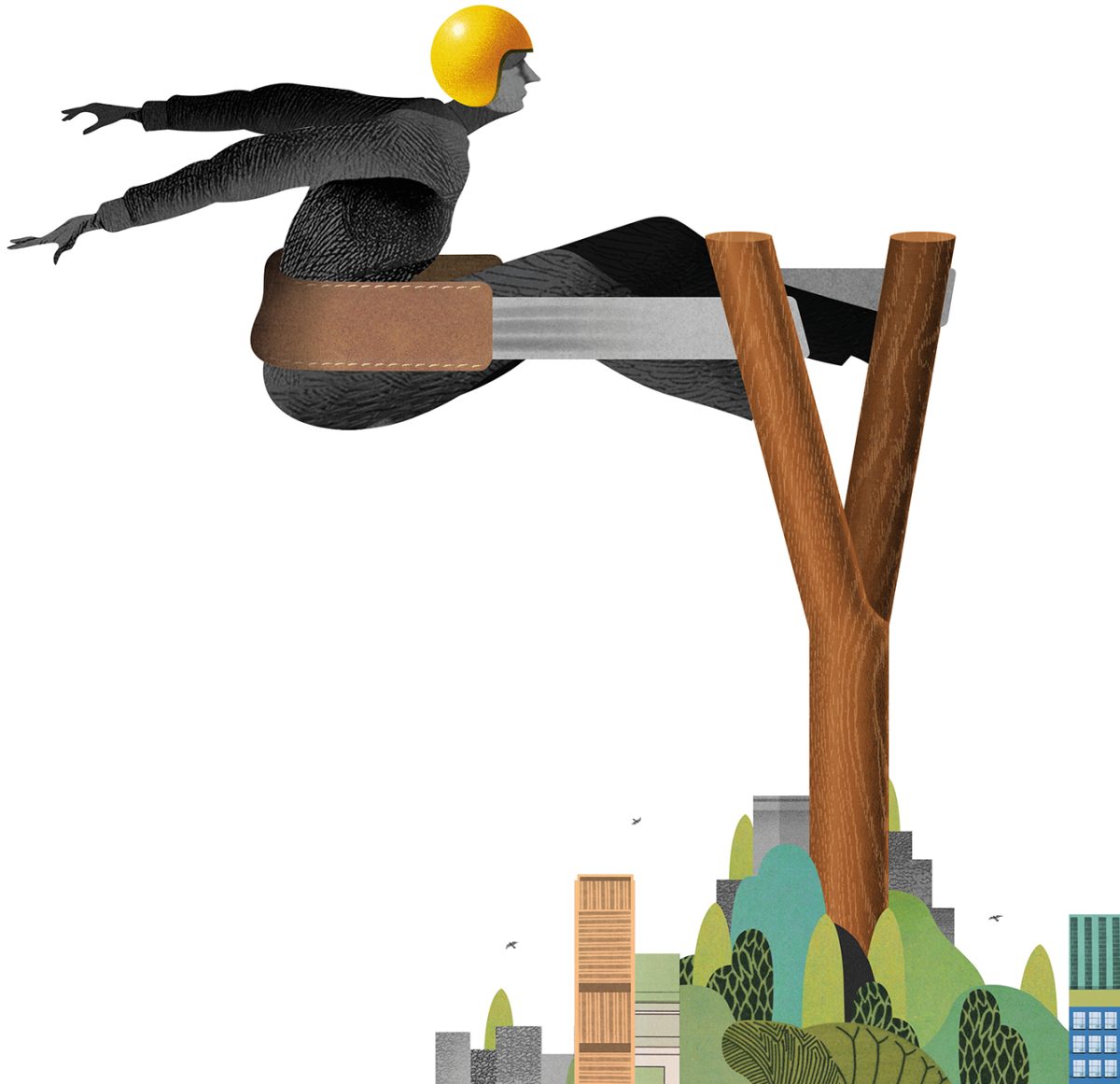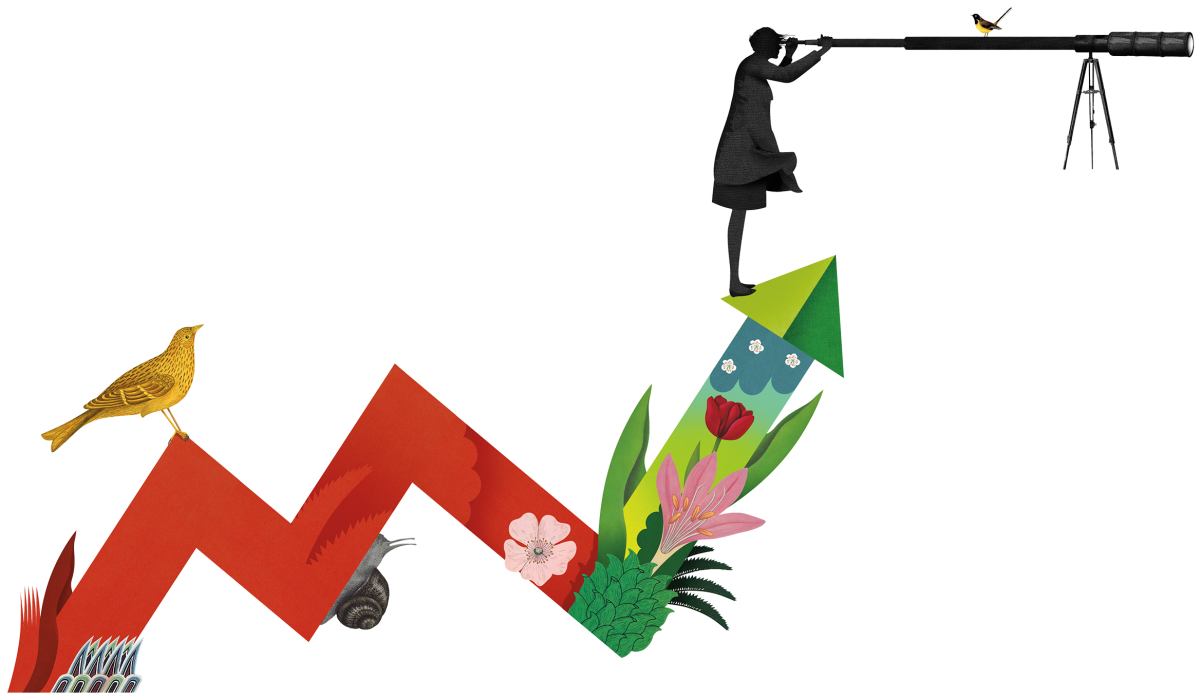Ready, Set, Startup
Starting a new venture from square one is like a years-long game of Chutes and Ladders — it takes ingenuity, sticktoitiveness and perhaps most of all, a high tolerance for risk to reach the top. Stevens has long been a place where innovators thrive, combining their technical know-how with an entrepreneurial mindset to solve some of the world’s toughest problems. And the university doesn’t just teach skills to be put to work after graduation — it provides resources and programs that encourage students to get started while they’re still in class.
In the story that follows, Stevens professors and alumni describe the highs and lows of launching and growing a startup — including some advice for a leg up along the way.
START with a meaningful problem...
One of the first steps aspiring entrepreneurs take in Stevens’ Launchpad program, led by Mukund Iyengar, isn't to come up with a product idea — it's to uncover a real pain point that affects lots of people. Students work for months to identify an unmet need that they are committed to solving. Discussions within the Launchpad group inspire iteration and introspection, often leading participants to land on issues they connect with personally. “When you see your own problems, it is only a matter of time before you start inventing novel pain killers,” says Iyengar. “And here's the neat thing — if you're an average person facing this problem, odds are high there are millions of others just like you.”
The problem-based approach applies outside of Stevens as well.
As a product development scientist, Trishna Saigal ’06 worked behind the scenes at major food companies to formulate new products and bring them to market. Passionate about healthy eating, she was attracted to developing vegan and plant-based foods — but felt discouraged when she saw how these products are formulated. “It got me thinking, ‘What can I do to help people eat plant-based food that isn’t highly processed or designed to mimic meat?’” says Saigal. “Healthy food is also expensive, so I wanted to create something that is accessible at the same time ... I know we could have a better food system in America — but change is hard and maybe not immediately profitable. I’m obsessed with finding a better way.”
Then FIGHT the urge to solve it in a vacuum.
“In my earlier ventures, I realize [now] that we didn’t have good product/market fit. We thought we were building for a certain type of customer with a certain type of problem, but we were just wrong about that, or the pain point wasn’t large enough, so the interest wasn’t there. When I started working on Instapaper, the product was informed directly by customers; people writing in with feature requests. I think the craft is how you take those problems and build solutions within a cohesive roadmap and strategy to bring it to market.” — Brian Donohue
“Entrepreneurs should have a passion for their idea, but that is not usually enough to be successful. It’s important to develop a clear value proposition, which starts with understanding the voice of the customer,” says Vikki Hazelwood.
Having a deep understanding of the market is also important to securing funding for your startup. “One of the biggest misconceptions about entrepreneurship is that you need a product built and ready to go before you have a conversation with investors,” says Philippe de Lurand Pierre-Paul. “What’s actually important is getting proximate to people who have a need. I look for how [entrepreneurs] are spending time to validate their hypotheses before they spend any time building a product.”
“Before I brought my product to grocery stores, I started selling it at farmer’s markets. It was a new concept, and I wanted to see how people would react to it before I got too far along. That summer of ‘consumer research’ helped me figure out what flavors people liked, what product name resonated and develop language for talking about the product.” — Trishna Saigal
In the beginning, you might have to get a little SCRAPPY...
Early in her career, Rita Gurevich was part of the team tasked with the quick division of Lehman Brothers’ technology assets following the company’s bankruptcy — an unprecedented project at the time. The team persevered through a massive data aggregation effort, cobbling together information from access reports and tools that weren’t purpose-built for the job. As instability grew in the banking industry, and the need for data privacy emerged, “I realized very quickly that other companies were going to want to take stock of their technology assets and data as a proactive measure,” she says.
Leading with the data detective skills she developed at Lehman, Gurevich bootstrapped SPHERE Technology Solutions to respond to the needs she forecasted in the financial industry. “I was 25 years old with about $1,000 in my bank account. I ate a lot of peanut butter and jelly and SpaghettiOs® and had to pretend I was this big shot,” she laughs. Initially, she leveraged her network to get her foot in the door with executives at other major banks. “I also did things to reduce risk for the buyer, like saying ‘Don’t pay me until I’m done,’ which is really scary when your bank account depends on it!”
But you don’t have to go it ALONE.
“Early-stage entrepreneur teams tend to be strong in ideation but lack necessary business skills. Rounding out the team with complementary skill sets is critical for the startup’s development. Investors know this and are far more willing to invest in a startup with a good team.” — Vikki Hazelwood
“The best technical founders know where their gaps are and fill them with trusted team members, and in some cases a CEO, to complement their technical leadership.” — Daniella Kranjac
“I have found that networking with fellow entrepreneurs, industry experts and potential mentors has been invaluable. Engaging in communities, attending industry events and leveraging social media platforms can provide opportunities for collaboration and learning, and open doors to new possibilities.” — Raj Sharma
“I have a small group of founders I meet with every two weeks to talk through what we’re going through. Sometimes it’s just venting, other times we’re sharing resources and helping each other with our businesses. I’m also part of a much larger group for minority founders that meets quarterly to listen to guest speakers.” — Trishna Saigal
A great PITCH includes facts and figures, but it’s also a chance to show who you are...
“It's important to clearly communicate your unique value proposition, demonstrate market demand, highlight your team's expertise, and provide a compelling financial forecast,” says Sharma. “Presenting a well-researched business plan, showcasing a prototype or MVP (Minimum Viable Product), and emphasizing your passion and dedication can significantly enhance your chances of securing funding,” he explains.
But interpersonal strengths can prove just as valuable as data. “While there are standard topics to present in a pitch, it is important to remember the investors are betting on the team,” Seth Tropper explains. “As an entrepreneur, what you’re doing at the end of the day may not be 100% of what you set out to do. What you’re selling is your ability to pivot and to be resourceful to get through the hard times.”
Kranjac also emphasizes the importance of a well-balanced team: “[For investors], it really comes down to the grit, perseverance and self-awareness of the leadership team — their ability to seek guidance and support and take action in uncertain situations,” she says. “You can have a great product, but a team without these qualities won’t get as far as a marginal product led by a great team.”
CHALLENGES abound, coming from more directions than you imagine.
“As a woman of color, my fundraising journey wasn’t as linear as it was for some of the startups I’ve worked at led by white men. I have other female friends with strong backgrounds in consumer package goods and research and development who also struggled to raise [funds]. Being a person with a different background than what the gatekeepers of the money are used to creates a tension of trust — and trust is what fundraising is all about.” — Trishna Saigal
“I often speak about entrepreneurship, and joke — but this is half true — that I had a ‘For Sale’ sign in my garage. If it was a bad week, the sign would be placed out on the lawn. If it was a good week, I could bring it inside again. Sometimes you can have the highest of highs and the lowest of lows all in the same day. We hear a lot about work-life balance, yet it is more about work-life harmonization. You need to have a strong support system and find a way to harmonize those for which you have passion for [your family and your venture].” — Seth Tropper
“I was in a leadership role at a startup, and we were getting ready to sell to another company. We had a term sheet signed, and it was going to be a really good financial outcome for everyone — I was shopping for houses. Then they pulled out due to a ‘strategic change.’ That was really hard ... About a year later after lots of ups and downs, we closed a different deal. Managing your emotional and psychological state through all of that, especially over a long period of time, is challenging.” — Brian Donohue
CHANGE can help you address challenges. Iterating on your initial concept is critical to growth.
“If something’s not working, don’t be afraid to change it,” says Barresi. “I started with a web application, then pivoted to a web browser, then to a web browser for financial services. Now we’re back to a web application that acts as a content aggregator for financial services. It’s important to evolve your product to find a market fit.”
Finding other applications for your product or technology can also be a game-changer. “Once you’ve defined your market, start thinking about an adjacent market,” suggests Al Sisto. “A one-trick pony is not likely to be a successful business. But if you’re developing a product or service that solves a problem in one sector, maybe by turning it 45 degrees, it becomes a must-have of another.”
Rita Gurevich realized this when expanding her business to new markets. “Who knew that other verticals (industries) would be impressed with what we’ve done in finance?” she says. As cybercrime becomes more sophisticated and widespread, more industries than ever are finding themselves vulnerable to bad actors. The ability to work with big-name, highly regulated institutions lent SPHERE credibility in other highly regulated fields with significant cybersecurity needs, says Gurevich.
Get into the GAME as early as you can...
“Starting a scaling company from scratch is one of the hardest acts in life. A college freshman is ignorant of that difficulty. This ignorance is an asset. On the other hand, folks five or 10 years into their careers may know their domains well but won't usually chase big ideas with reckless abandon.” — Mukund Iyengar
“The best time to do it is when you’re in school — nothing bad will happen to you if you fail. Worst case, you have a phenomenal resume booster. The right prospective employers will appreciate an entrepreneurial mindset.” — Kevin Barresi
“I think the fear of risk prevents a lot of people from taking the leap into entrepreneurship. What a lot of people don’t think enough about, especially younger folks, is the opportunity risk of not doing it — the skills they won’t learn and the network they won’t build. I think the easiest time to do it is when you’re used to eating ramen in your dorm room for breakfast, lunch and dinner and don’t have a mortgage or many other expenses.” — Brian Donohue
Because if you can push through the lows, there are lots of ‘WINS’ to be had.
The ability to build something that makes a difference for others was almost unanimously cited as a motivating factor for our Stevens guides. In turn, the feeling of making an impact enriched their own lives.
“Working with customers is so much fun. Hearing about peoples’ experiences with something you created is amazing,” says Saigal. Some of the most meaningful feedback she’s received has been from customers who feel her products support their dietary needs as they deal with allergies or are undergoing cancer treatment.
“Switch2Health was a venture where we helped improve the lives of so many.” says Tropper. “We received countless messages and heard numerous stories where individuals engaged in our platform and improved their health and well-being.” Some users also included their families in their journey to improved health, he recalls. “While challenges and even setbacks are inevitable, knowing we were making a positive improvement in people’s lives fueled our drive to continue.”
“At every stage of my career, I’ve been involved in businesses that have changed the world in some way,” says Sisto. He’s been part of major milestones in tech, including the development of microprocessors in the late ’70s and early ’80s, pioneering computer-generated imagery in the early ’90s and lobbying for changes in encryption law in the late ’90s. Now, he marvels at the AI-based innovations in healthcare and life sciences he helps fund through his VC. “I feel good being able to point at different things like that and say, ‘Hey, I was part of something that made a difference.’”
— Erin Lewis






